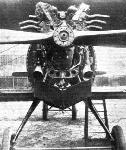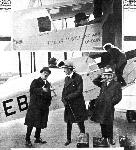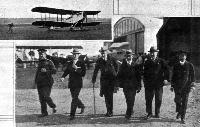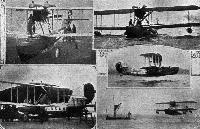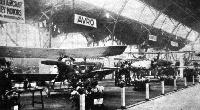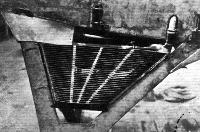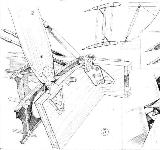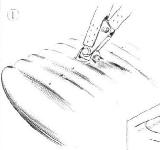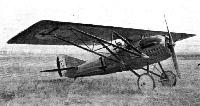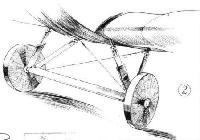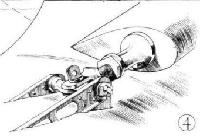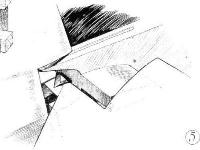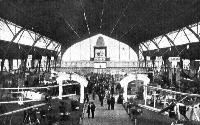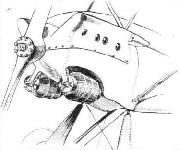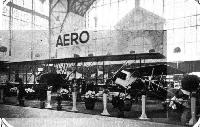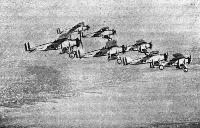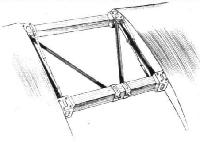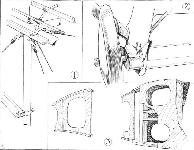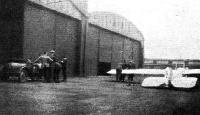Фотографии
-
THE BREGUET XIX, 400 H.P. LORRAINE-DIETRICH ENGINE: This actual machine was used by Lieut. Pelletier d'Oisy on his flight to the East.
Самолёты на фотографии: Breguet Br.19 - Франция - 1922
-
Front View of the Breguet XIX, showing mounting Lorraine-Dietrich engine. Note the Andre retractable radiator.
Самолёты на фотографии: Breguet Br.19 - Франция - 1922
-
One side of the undercarriage of the Breguet XIX. Note the single strut undercarriage, the streamline axle fairing, and the Artillery type wheel instead of the usual wire-spoke type.
Самолёты на фотографии: Breguet Br.19 - Франция - 1922
-
The Henry Potez type XV Observation Biplane, fitted with a 370 h.p. Lorraine-Dietrich engine.
Самолёты на фотографии: Potez Potez XV / XVII / 27 - Франция - 1921
-
A new Junkers' three-seater: This machine, to which reference was made in FLIGHT recently, is a departure from Junkers' practice in having the wing placed on top instead of low down on the fuselage. The cabin has accommodation for two passengers, and as the engine is a Siemens of 60 h.p. only, the machine is using but 20 h.p. per occupant, which should give very economical running.
Самолёты на фотографии: Junkers K 16 - Германия - 1921
-
COMMERCIAL AVIATION IN AUSTRALIA: The Western Australian Airways, Ltd., Depot at Perth, and some of the machines - Bristol Tourers and Avro.
Самолёты на фотографии: Avro Avro 504 - Великобритания - 1913Bristol Tourer - Великобритания - 1919
-
FLYING TO PRAGUE: On Friday, May 30 Lord Thomson, Secretary of State for Air, General Sir Sefton Brancker, and Mr. Frank Hodges made the flight from London to Prague in a D.H. 50 (240 Siddeley-Puma), Piloted by Captain Broad.Leaving Croydon at 7.30 a.m., the party arrived on the Kbely aerodrome at Prague at 4.40 p.m. Mr. Hodges was on his way to Vienna, while Lord Thomson and General Sir Sefton Brancker were attending the opening by Professor Masaryk, President of the Czechoslovak Republic, of the Third International Aero Exhibition in Prague. Our photograph shows the three air travellers in merry mood a moment before the departure. Above the luggage is being loaded on board.
Самолёты на фотографии: De Havilland D.H.50 - Великобритания - 1923
-
BRITAIN'S AIR MINISTER AT PRAGUE: Our photograph shows Lord Thomson with several notabilities who met him on his arrival at the Kbely aerodrome. Inset shows the D.H.50 landing on the Prague aerodrome, carrying Lord Thomson, General Sir Sefton Brancker, and Mr. Frank Hodges. The flight from Croydon to Prague was accomplished in a little under nine hours.
Самолёты на фотографии: De Havilland D.H.50 - Великобритания - 1923
-
Регистрационный номер: M-NSAA A NEW SUPERMARINE AMPHIBIAN FOR SPAIN: The engine is a Rolls-Royce "Eagle IX." The machine carries pilot, gunner, and observer forward. A camera is fixed in the interior of the hull, where also bombs are carried.
Самолёты на фотографии: Supermarine Sea Eagle - Великобритания - 1923
-
A CORNER OF THE BRITISH EXHIBIT AT PRAGUE: In the foreground the Armstrong-Whitworth "Siskin," with Siddeley "Jaguar" engine.
Самолёты на фотографии: Armstrong Whitworth Siskin - Великобритания - 1921
-
The "Avia" B.H.3.is a single-seater scout, fitted with the new Walter 220 h.p. engine. The radiator is placed under the fuselage.
Самолёты на фотографии: Avia BH-3 / BH-4 - Чехословакия - 1921
-
The "Avia" B.H.7 parasol monoplane single-seater fighter. The engine is a 300 h.p. Hispano-Suiza. Note the radiators placed between the chassis struts.
Самолёты на фотографии: Avia BH-7 - Чехословакия - 1923
-
One of the chassis-strut radiators of the "Avia" B.H.17. These radiators are manufactured by the "Avia" company. Shutters for varying the cooling are mounted on the front struts, but are not in place in the photograph.
Самолёты на фотографии: Avia BH-8 / BH-17 - Чехословакия - 1923
-
Details of wing construction of the B.H.17 biplane. The single interplane strut is braced by large turnbuckles at top and bottom, as indicated in the diagrams. Spars and ribs are of similar construction to that used in other "Avia" machines.
Самолёты на фотографии: Avia BH-8 / BH-17 - Чехословакия - 1923
-
Undercarriage and retractable radiator of the "Avia" B.H.19. This machine is a low-wing single-seater monoplane fighter with 300 h.p. Hispano-Suiza engine.
Самолёты на фотографии: Avia BH-19 - Чехословакия - 1924
-
SOME GERMAN CONSTRUCTIONAL DETAILS AT PRAGUE: 1. The strut-attachment on the lower plane of the Junkers type "U."
Самолёты на фотографии: Junkers T 21 / Ю-21 / J 22 / T 26 - Германия - 1923
-
SOME GERMAN CONSTRUCTIONAL DETAILS AT PRAGUE: 2. Attachment of lower plane to fuselage on the same machine.
Самолёты на фотографии: Junkers T 21 / Ю-21 / J 22 / T 26 - Германия - 1923
-
The Gourdou-Leseurre Monoplane, 180 h.p. Hispano-Suiza engine.
Самолёты на фотографии: Gourdou-Leseurre GL-2 / GL-21 / GL-22 / GL-23 / GL-40 - Франция - 1919
-
The Junkers type "A" twin-float seaplane. The machine exhibited had a slightly different nose radiator.
Самолёты на фотографии: Junkers J 20 / Ю-20 - Германия - 1922
-
SOME GERMAN CONSTRUCTIONAL DETAILS AT PRAGUE: 4. In the Albatros L.59/60 the slot between rudder and fin and between elevator and tail plane is covered with hinged aluminium strips.
Самолёты на фотографии: Albatros L.59 / L.60 - Германия - 1923
-
Регистрационный номер: L-BONA [3] The "Avia" B.H.12, with 60 h.p. Walter engine, has been specially built for the Brussels competition. Three-quarter front view.
Самолёты на фотографии: Avia BH-9 / BH-10 / BH-11 / BH-12 / BH-16 - Чехословакия - 1923
-
Регистрационный номер: L-BONA [3] THE AVIA B.H.12 WITH WINGS FOLDED. The wings pivot around the front spar, and are then secured to the fuselage, when the machine can be trailed behind a car or motor bicycle, or even wheeled along by hand, as show in the photograph.
Самолёты на фотографии: Avia BH-9 / BH-10 / BH-11 / BH-12 / BH-16 - Чехословакия - 1923
-
The "Avia" B.H. 16 is a light 'plane single-seater, and will be fitted with a Blackburne engine. The engine shown in this photograph is a Vaslin.
Самолёты на фотографии: Avia BH-9 / BH-10 / BH-11 / BH-12 / BH-16 - Чехословакия - 1923
-
Самолёты на фотографии: Avia BH-9 / BH-10 / BH-11 / BH-12 / BH-16 - Чехословакия - 1923
-
Регистрационный номер: L-BONA [3] THE "AVIA" B.H.12. Three-quarter rear view.
Самолёты на фотографии: Avia BH-9 / BH-10 / BH-11 / BH-12 / BH-16 - Чехословакия - 1923
-
The "Avia" B.H.9. two-seater sporting machine, fitted with 60 h.p. Walter radial engine.
Самолёты на фотографии: Avia BH-9 / BH-10 / BH-11 / BH-12 / BH-16 - Чехословакия - 1923
-
GENERAL VIEW FROM THE THIRD INTERNATIONAL AERO EXHIBITION AT PRAGUE: The "Avia" B.H.9.
Самолёты на фотографии: Avia BH-9 / BH-10 / BH-11 / BH-12 / BH-16 - Чехословакия - 1923
-
The "Avia" B.H.10 single-seater 60 h.p. Walter engine.
Самолёты на фотографии: Avia BH-9 / BH-10 / BH-11 / BH-12 / BH-16 - Чехословакия - 1923
-
Undercarriage of the B.H.16 light 'plane. The springing is provided by rubber blocks in compression.
Самолёты на фотографии: Avia BH-9 / BH-10 / BH-11 / BH-12 / BH-16 - Чехословакия - 1923
-
A typical "Avia" strut fitting. The sketch was actually made from the type B.H.12.
Самолёты на фотографии: Avia BH-9 / BH-10 / BH-11 / BH-12 / BH-16 - Чехословакия - 1923
-
The manner of mounting the balanced elevator and rudder on most of the "Avia" machines. The small fixed tail plane is rigidly built into the tail portion of the fuselage.
Самолёты на фотографии: Avia BH-9 / BH-10 / BH-11 / BH-12 / BH-16 - Чехословакия - 1923
-
THE DEWOITINE MONOPLANE, 300 H.P. HISPANO-SUIZA ENGINE: The machine actually exhibited at Prague is fitted with the new type Lamblin radiators mounted on the struts of the undercarriage.
Самолёты на фотографии: Dewoitine D.1 / D.9 - Франция - 1922
-
GENERAL VIEW FROM THE THIRD INTERNATIONAL AERO EXHIBITION AT PRAGUE: The photograph shows the British stand, with the "Avro-Lynx" on the left and the Blackburn "Dart" on the right.
Самолёты на фотографии: Avro Avro 504N - Великобритания - 1920Blackburn Swift T.1 / Dart T.2 - Великобритания - 1920
-
Two views of the Bleriot-Spad 81 C.1, 300 h.p. Hispano-Suiza engine.
Самолёты на фотографии: Bleriot-SPAD S.81 - Франция - 1923
-
The Spad 81 C.1 has its two Lamblin radiators mounted in a somewhat unusual fashion, as shown in this sketch.
Самолёты на фотографии: Bleriot-SPAD S.81 - Франция - 1923
-
THE HAWKER "WOODCOCK": Another recent single-seater fighter biplane, fitted with a Bristol "Jupiter."
Самолёты на фотографии: Hawker Woodcock - Великобритания - 1923
-
TWO OF THE "AERO" MACHINES AT THE PRAGUE EXHIBITION: The machine on the left is the twin-engined bomber, "Ae.24." On the right the "Ae.18."
Самолёты на фотографии: Aero A.18 / A.20 - Чехословакия - 1923Aero A.24 - Чехословакия - 1924
-
THE D.H.53 LIGHT MONOPLANE: This machine, fitted with a 696 c.c. Blackburne engine, has been sent to Prague, where it will give demonstration flights at the Kbely Aerodrome. It was on a similar machine that Mr. Alan J. Cobham flew from London to Brussels in less than four hours.
Самолёты на фотографии: De Havilland Humming Bird / D.H.53 - Великобритания - 1923
-
THE FOKKER T-III MONOPLANE: The machine shown above is a three-seater low-wing cantilever monoplane, which is fitted with either a 450 h.p. Napier "Lion" or a 360 h.p. Rolls-Royce "Eagle." Several af this type have been - or are being - constructed for the Portuguese Government, and it was the type of machine which Admiral Continho and Commdr. Sacadura Cabral selected for their world-flight. If required, the wheels may be replaced by two floats. Its span is 69 ft. 6 ins.; overall length, 42 ft. 6 ins.; wing area, 775 sq. ft.; and speed 111-6 m.p.h.
Самолёты на фотографии: Fokker T.II / T.III - Нидерланды - 1921
-
The "S.6" of the Czech Military Aircraft Factory is a two-seater reconnaissance machine with 260 h.p. Maybach engine.
Самолёты на фотографии: Letov S-6 - Чехословакия - 1923
-
AMERICAN FORMATION FLYING: Fighting Squadron One, Aircraft Squadrons, U.S. Battle Fleet, flying over San Diego harbour. The machines are "T.31" fighters, fitted with 200 h.p. Wright (Lawrence) "J.1" radial air-cooled engines.
Самолёты на фотографии: Naval Aircraft Factory TS - США - 1922
-
FROM THE GERMAN GLIDER AND LIGHT PLANE EXPERIMENTS AT ROSSITTEN, NEAR KOENIGSBERG: On the left, Herr Arthur Martens being catapulted off on his machine "Max," and on the right a picture of Martens standing by the 4 h.p. engine of his machine.
Самолёты на фотографии: Hannover H.1 Vampyr / H.2 Greif / Strolch - Германия - 1921
-
The engine cowling of the " Ae.20." The engine is a 300 h.p. Hispano-Suiza. The radiator is a special "Aero" type, and incorporates a "comb" between the segments for varying the cooling.
Самолёты на фотографии: Aero A.18 / A.20 - Чехословакия - 1923
-
The open centre-section of the lower plane of the "Ae.18." The wing is in one piece, and rests in a cut-out in the bottom of the fuselage, being secured by four bolts at each corner of the panel.
Самолёты на фотографии: Aero A.18 / A.20 - Чехословакия - 1923
-
The Dietrich-Gobiet "D.P.VIIA'' parasol monoplane with Siemens radial engine.
Самолёты на фотографии: Dietrich DP.VII / DP.VIIa - Германия - 1924
-
SOME GERMAN CONSTRUCTIONAL DETAILS AT PRAGUE: 3. The parasol monoplane wing of the Dietrich-Gobiet is attached to the fuselage by four tubular tripods.
Самолёты на фотографии: Dietrich DP.VII / DP.VIIa - Германия - 1924
-
The "Aero" A.12 two-seater fighter and reconnaissance biplane, with 260 h.p. Maybach engine. On the right a view of the engine with cowl removed. Note the curiously-shaped side-radiators.
Самолёты на фотографии: Aero A.12 - Чехословакия - 1923
-
The "S.8" racing monoplane of the Czech Military Aircraft Factory. This machine is fitted with a Napier "Lion" engine, and is credited with a speed of 360 km/h. (225 m.p.h.).
Самолёты на фотографии: Letov S-8 - Чехословакия - 1923
-
SOME SMOLIK DETAILS: Metal construction is largely employed by the Czech Military Aircraft Factory, a typical example of fuselage construction being shown in 1. 2 shows the undercarriage of the S.8, a monoplane racer with Napier "Lion" engine. Lamblin radiators, of the new strut type, are to be fitted on the chassis legs. In 3 are shown examples of wood wing construction.
Самолёты на фотографии: Letov S-8 - Чехословакия - 1923
-
VIEW OF SOME OF THE HANGARS ON ALEXANDRA PARK AERODROME: On the right may be seen the Monoplane Glider constructed by members of the Lancashire Aero Club
Самолёты на фотографии: Lancashire Aero Club LPW (Leeming-Prince-Wood) - Великобритания - 1924
-
TWO VIEWS OF THE ALBATROS "L.66" LIGHT MONOPLANE: The engine shown is the Haacke, used in the early experiments, and it is stated that an engine of 30-40 h.p. will be fitted, of any type desired by the purchaser.
Самолёты на фотографии: Albatros L.66 - Германия - 1924
-
SOME GERMAN CONSTRUCTIONAL DETAILS AT PRAGUE: 5. The unusual termination of the top longerons in the Albatros L.66.
Самолёты на фотографии: Albatros L.66 - Германия - 1924
-
The Dietrich-Gobiet "D.P.IIa" is a two-seater biplane with Siemens radial engine.
Самолёты на фотографии: Dietrich DP.II - Германия - 1923
-
CZECHO-SLOVAK CONCEPTION OF COMMERCIAL AEROPLANES: These three scale models represent designs either actually in course of construction or contemplated by the Military Aircraft Factory, to the designs of Ingenieur Smolik. 1 shows the "S.15," with four Hispano-Suiza engines placed in tandem in the wings. The propeller efficiency of the pusher screws aft of such a deep wing seems a somewhat doubtful quantity. In 2 is shown the model of a three-engined machine, in which the tractor engine in the fuselage is a Napier "Lion," while the two pushers are B.M.W. engines of 220 h.p. each. 3 shows a seven-engined design, but this has, we believe, been abandoned as being too ambitious.
Самолёты на фотографии: Letov S-9 / S-15 / S-137 - Чехословакия - 1924
-
Регистрационный номер: J7005 At the Pageant: THE DE HAVILLAND "DORMOUSE": A recent "hush-hush" two-seater fighter biplane.
Самолёты на фотографии: De Havilland Dormouse/Dingo/D.H.42 / Hyena/D.H.56 - Великобритания - 1923
Статьи
- Flight

